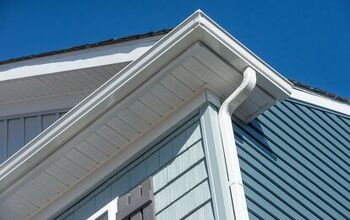4-inch Vs. 8-inch Faucet: Which One Is Better?

Updating or replacing a faucet seems like a simple task until you get to the hardware store. The number of styles, colors, and features can be a LOT to consider for something that gives you running water. How do you even begin to know which faucet will work best for your needs?
The two most common faucet sizes measure 4 inches and 8 inches across, respectively. The 4-inch faucets are more often centerset models and work well in bathrooms. 8-inch faucets stretch further across and tend to be widespread models, ideal for kitchen sinks and more expansive bathroom sinks.
The faucet’s dimensions come from the distance between the center of the drilled holes for the faucet and the handles. First, you’ll need to measure the back edge of your sink or counter where you plan to place the faucet. Then, once you determine how much space you have to work with, you can choose the appropriate tap for your space.
Do You Need a Faucet, Fixture, or Pipe Repair or Replacement?
Get free, zero-commitment quotes from pro contractors near you.

4-Inch Faucets
The 4-inch faucet is the most commonly compatible faucet for pre-drilled sinks and countertops. This is due to the fact that their compact size fits into just about any space quickly and easily. They are usually attached to a base plate and come in three-hole and one-hole models.
Three-hole models have two handles on either side of the faucet arranged in line in the deck plate. Likewise, one-hole models have the faucet handles and spout in one body piece without a deck plate. Because this faucet style is so compact, you don’t need more than one hole to seat the faucet.
8-Inch Faucets
8-inch faucets stretch out further, measuring 8 inches from the center hole midpoint to the handle hole midpoint. Because they are so much longer, they usually fall under the widespread faucet category. These faucets typically come as three separate pieces but can include a deck plate.
The components for 8-inch faucets can span as far as 20 inches apart. This quality makes them an excellent choice for larger counters and sinks. Also, it allows these faucets the flexibility to fit into virtually any sized space.
Comparing 4-Inch and 8-Inch Faucets: Which Should I Choose?
Deciding between a 4-inch faucet and an 8-inch faucet means considering the space and location you install it. For example, a small pedestal sink may be too small for an 8-inch fixture. Likewise, a large countertop or sink space would dwarf a 4-inch fixture.
Style and function are two other essential concerns in the selection process. There’s a myriad of faucet types, styles, and finishes that help add a designer touch to your kitchen or bathroom. On the other hand, you may need something more utilitarian for a workspace or laundry room.
Benefits of 4-Inch Faucets
The universality and widespread availability of 4-inch faucets are two of their most significant advantages. More commonly known as a centerset faucet, the 4-inch faucet is the standard unit on the market. This is because they are easy to find just about anywhere and usually the most affordable.
The 4-inch faucet’s simple, compact design is another asset that makes it a great choice. Since all of the components are built into one piece, you can’t misplace any parts. Plus, its single-body construction is easy to drop in and pre-sized to standard sink measurements.
The compact, all-in-one design also benefits users outfitting very small spaces and sinks. The 4-inch faucet’s total length is small enough to accommodate an average-sized bathroom sink. Additionally, it also comes in a one-handled option that only needs one hole for installation.
Drawbacks of 4-Inch Faucets
While its size offers many benefits, the 4-inch faucet’s dimensions do have some limitations. You can only use them on small scale sinks, as larger, deeper sinks would overtake them in design. Additionally, they would likely take longer to fill the basin and give inadequate space under the spout.
Another issue with the 4-inch faucet is its rigid placement. The all-in-one unit will only fit into precisely measured holes and usually toward the sink’s rear center. So if you needed to corner mount the fixture, it wouldn’t adapt to the space.
While the majority of 4-inch faucets are budget-friendly, you do get what you pay for. For example, getting a high arc faucet will cost you more, as well as a fancy metal or high-end finish. Plus, you would be more likely to replace the faucet more frequently due to malfunction.
Benefits of 8-Inch Faucets
The 8-inch faucet offers more placement versatility, allowing for more space and creative settings. You can install them as closely as a 4-inch faucet or group them on a corner sink. Furthermore, you can also place the faucet spigot and handles anywhere within 8 to 16 inches apart.
A great advantage of the 8-inch faucet’s spacing is how much easier it is to clean. With 4 inch faucets, you can’t always reach grime that settles in the cracks and crevices beneath spigots and handles. However, the 8-inch faucet’s wider spacing allows for a 360-degree reach around the fixtures to thoroughly clean more surface area.
Because 8-inch faucets are usually widespread models made up of three individual components, it’s easier to repair or replace. For example, if a handle breaks, you can simply replace that one piece and leave the others intact. This is much simpler than having to replace an entire faucet assembly as you would with a 4-inch faucet.
Drawbacks of 8-Inch Faucets
As flexible as 8-inch faucets are in design and placement, the initial installation is a more involved process. You can’t just drop it in like a one-piece 4-inch assembly; each individual component gets installed separately. For the do-it-yourselfer, the installation can be tricky and require a professional.
It’s easier to lose or misplace a piece in the installation process, as well. There’s little chance of losing a faucet handle on a 4-inch faucet because everything’s built into one piece. However, the three individual pieces and connectors have more potential to disappear.
A significant disadvantage of 8-inch faucets is that they typically cost more than their 4-inch counterparts. Quality, as well as separate components, has a higher price tag than single-digit 4-inch faucets. So, it’s worth considering that it may be worth it in the long run but could strain short-term budgets.
Related Questions
How big should you cut a faucet hole?
If your sink or countertop isn’t pre-drilled, or if the holes and fixtures are incompatible, you’ll need to measure carefully. A typical hole for a standard, on-air gap is 7/16 inches diameter or larger. You can even go as large as 1¼ inches and still have the faucet components fit flush in the hole.It’s important not to go too wide with the hole’s diameter when drilling for fixtures. A 1½ inch diameter can work but typically hamper proper fitting of the base plate when covering the hole. Therefore, a widespread faucet would be the best option for a hole this size.
Which kind of faucet drips the least?
With all the different looks and finishes faucets offer, your main priority in buying one is proper function. You want the handles to move smoothly and easily and the water to flow freely and steadily. Most importantly, you want to make sure water comes out only when you want it to.The best way to ensure a drip-free faucet is to find one fitted with ceramic valves. Of the types of faucet valves available, the ceramic is the most durable and reliable long-term. The best news is that faucets with ceramic valves are comparably priced with other faucets.
Is a waterfall faucet a good choice?
Waterfall faucets are a newer innovation in bathroom faucets where the water cascades from a sloped, open spout. They tend to be more expensive than other models and more complicated to install. However, the benefits of getting a waterfall faucet outweigh most of the drawbacks.For example, they reduce water flow and provide a relaxing, spa-like experience and a touch of luxury to your space. Additionally, they are easier to clean, comfortable to use, splashproof, and feature a space-saving design. Therefore, a waterfall faucet is not only an excellent option, but it can also add to your property value.
Do You Need a Faucet, Fixture, or Pipe Repair or Replacement?
Get free, zero-commitment quotes from pro contractors near you.

What’s The Verdict?
The best faucet between the 4-inch and 8-inch depends significantly on the space where it’s installed. Renovation budget, timeframe, and skill level will also determine your selection, as well as intended function and personal style. However, the 4-inch faucet and the 8-inch faucet best lend themselves to specific conditions.
The 8-inch faucet is more flexible in spacing, so it will work with nearly any sink or counter setup. The fixtures have more room to move freely and open fully, clearing the back wall and faucet spigot with ease. Therefore, for style and functionality, the 8-inch is your best option.
If you need a more straightforward installation process, the 4-inch faucet would be most optimal. Its small-scale, one-piece design is the easiest for even a novice do-it-yourselfer to connect. Plus, its widespread popularity and availability make it the easiest to find for purchase.

Stacy Randall is a wife, mother, and freelance writer from NOLA that has always had a love for DIY projects, home organization, and making spaces beautiful. Together with her husband, she has been spending the last several years lovingly renovating her grandparent's former home, making it their own and learning a lot about life along the way.
More by Stacy Randall













![10 Best Cordless Leaf Blowers – [2022 Reviews & Ultimate Guide]](https://cdn-fastly.upgradedhome.com/media/2023/07/31/9070789/10-best-cordless-leaf-blowers-2022-reviews-ultimate-guide.jpg?size=350x220)













